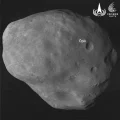
NASA’s Juno spacecraft is about to get super cozy with Jupiter moon Europa. Juno’s gearing up for the closest flyby of the moon in decades. The probe will gather data and images during its close approach, scheduled for Thursday, Sept. 29.
Europa is a bit of a solar system celebrity. It’s an icy world that’s a little smaller than Earth’s moon. Researchers are particularly interested in what may lurk beneath. “Scientists think a salty ocean lies below a miles-thick ice shell, sparking questions about potential conditions capable of supporting life underneath Europa’s surface,” NASA said. Check here.
Juno will zoom by within 222 miles (358 kilometers) of Europa’s surface. That’s roughly the distance from Washington, D.C. to New York City. NASA expects it will send back some of the highest-resolution images ever taken of the intriguing moon.
Juno arrived in Jupiter orbit in 2016 and earned itself a mission extension in 2021 that tasked it with studying the gas giant’s rings and some of its biggest moons. It already took a gander at the moon Ganymede and now it’s ready to give Europa some time in the spotlight.
We can expect knockout pictures, but Juno will also be in full data collection mode. The spacecraft’s instruments will investigate the composition and temperature of the moon’s icy shell. It will also seek to learn more about the moon’s ionosphere (part of its atmosphere) and how the moon interacts with Jupiter.
We’re circling back to Europa! Juno will be flying by Europa on the 29th for the 1st close look since the Galileo mission 22 years ago! Galileo found evidence of a liquid water ocean under Europa's icy surface.
More on Europa and NASA's upcoming mission: https://t.co/jg226k8zWv pic.twitter.com/rYYbE8Xqg3
— NASA History Office (@NASAhistory) September 24, 2022
Scientists are keeping their fingers crossed that Juno might be able to catch one of the moon’s elusive geysers. “We have the right equipment to do the job, but to capture a plume will require a lot of luck,” said Juno Principal Investigator Scott Bolton. “We have to be at the right place at just the right time, but if we are so fortunate, it’s a home run for sure.”
All this new information will help NASA with planning for its upcoming Europa Clipper mission, which will seek to understand the moon’s potential ability to host life in its watery clutches.
On Sept. 29, NASA’s Juno mission will be making the closest fly-by of Europa, one of Jupiter’s moons, in many years! Scientists think it might be possible to find life on Europa, a moon with an ocean encased in an icy shell.
Learn more about Europa here: https://t.co/LhyeCzTjpr pic.twitter.com/da8OJPLeJO
— NASA Space Place (@NASAspaceplace) September 21, 2022
The last time a spacecraft was this close to Europa was back in 2000, when the Galileo mission got snuggly with it. Juno won’t be content with bagging just Ganymede and Europa. The moon Io will be next in line in 2023.






